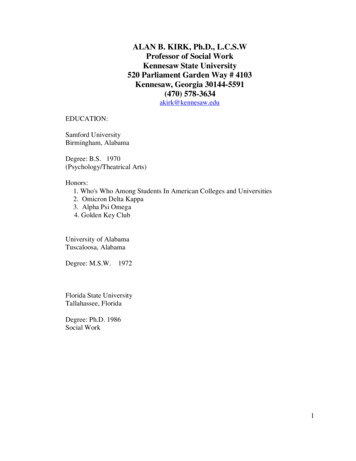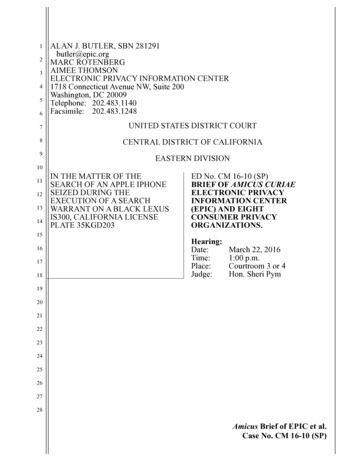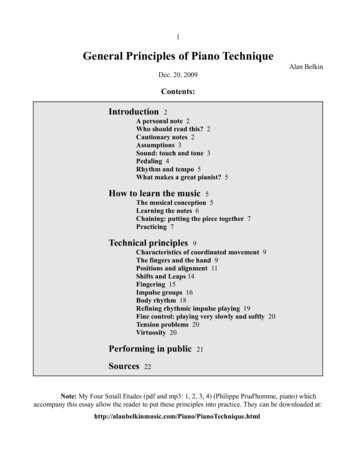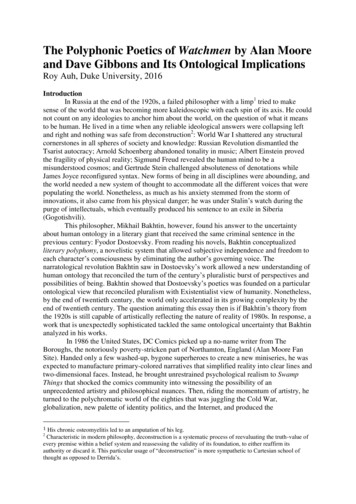
Transcription
ALAN B. KIRK, Ph.D., L.C.S.WProfessor of Social WorkKennesaw State University520 Parliament Garden Way # 4103Kennesaw, Georgia 30144-5591(470) 578-3634akirk@kennesaw.eduEDUCATION:Samford UniversityBirmingham, AlabamaDegree: B.S. 1970(Psychology/Theatrical Arts)Honors:1. Who's Who Among Students In American Colleges and Universities2. Omicron Delta Kappa3. Alpha Psi Omega4. Golden Key ClubUniversity of AlabamaTuscaloosa, AlabamaDegree: M.S.W.1972Florida State UniversityTallahassee, FloridaDegree: Ph.D. 1986Social Work1
WORK EXPERIENCE2015-PresentProfessor of Social WorkKennesaw State UniversityBeginning this academic year, I transferred leadership of the Social Work Program to anInterim Director. I am now a full-time member of the faculty. I am using this time tofocus on writing, development of two research projects, and expansion of our studyabroad initiatives.2008-2015Director, Master of Social Work ProgramDepartment of Social Work and Human ServicesKennesaw State UniversityKennesaw, GeorgiaThis was a full-time senior level administrative and teaching position. The Social WorkProgram is a nationally accredited program (Council On Social Work Education). Afaculty of 14 full-time and 8 part-time professors serve more than 120 full and part-timegraduate students. Specific responsibilities included leadership, management oversight,teaching, community relations, and strategic planning.Leadership Highlights:1. Led in CSWE Reaffirmation process that resulted in accreditation until 2021.The Department accomplished this without consultants or designated writers.2. Expanded our involvement in international study and internship experiences.We now offer experiential learning in Thailand, Germany, Belgium, France,Uganda, Malaysia, Morocco, and South Africa.2012-PresentVisiting FacultyErastus Mundus Masters Program in AdaptedPhysical ActivityThe Katholieke University LeuvenLeuven, BelgiumTeaching courses related to trauma, disaster intervention and the neuro-biology oftrauma. I also serve as a research advisor on thesis projects2
2012-PresentVisiting FacultyUniversity of MunichMunich, GermanyServed on 2 doctoral dissertation committees. Both PhD Candidates successfullydefended.2001-2008Professor and ChairDepartment of Social Work and Human ServicesKennesaw State UniversityKennesaw, GeorgiaThis was a senior level administrative and teaching position. The Human ServiceDepartment offers both the Master’s Degree of Social Work and the BS degree inHuman Services ten full-time and 18 part-time professors serve more than 350undergraduate majors and 70 full-time graduate students. Specific responsibilitiesincluded leadership, management oversight, teaching, community relations, and strategicplanning. A major emphasis began in 2005 to develop a nationally accredited (CSWE)Master of Social Work program. This program received a full seven (7) yearsaccreditation on 2008 (back dated to 2006). The MSW program has now completed itsfirst reaffirmation process and has received full CSWE Accreditation until 2021.Teaching specialty areas included research methodology, statistics, human behavior,child welfare, psychopathology, organizational development, and leadership skills.Leadership Highlights:1. Expanded faculty from 4 full-time and 5 part-time faculty to 10 full-time and16 part-time faculty members.2. Undergraduate majors increased from 145 to 400 during the first 5 years.3. Established a full-time Master of Social Work Program. Program is now infinal phase of candidacy. MSW Program has 70 full-time students.4. Grant writing activities resulted in 990,000 of external funding for academicprograms.5. Established international training programs based in Germany and SoutheastAsia.3
2003 – PresentVisiting ProfessorOrganizational Leadership Ph.D. ProgramUniversity of Maryland Eastern ShorePrincess Anne, MarylandTeaching 3-4 courses per year in the Ph.D. program. Courses include QuantitativeResearch Methods, Computer Assisted Data Analysis, Statistics and Data Analysis,Health and Human Service Policy, Organizational Research, and Dissertation Seminar.Non-teaching responsibilities include directing dissertations as either major professor orresearch advisor for 8 students.2003 – PresentVisiting ProfessorPh.D. ProgramSchool of Social WorkClark Atlanta UniversityAtlanta, GeorgiaTeaching one upper level doctoral course per semester. Serving on dissertationcommittees as research methodologist.1998-2001Associate ProfessorDirector, Social Work Program (BSW)Southeastern Louisiana UniversityHammond, LouisianaResponsibilities included research, teaching, and curriculum development within amulti-disciplinary department at this university. Primary courses were researchmethodology, statistics, human behavior, social work practice, and social welfare policy.Administrative responsibilities included leadership of an academic program with morethan 400 majors and 8 full time professors. The Social Work Program also had alaboratory clinic that employs 18 professional staff with a budget of 1.5 Million. Iserved as CEO of this activity. Community activities involved serving on severalagency boards including the Children Trust Fund which is a governor appointedposition. Work responsibilities included supervision of teaching faculty, administrativeoversight of the Social Work Program, curriculum development, student mentoring andadvisement, and liaison with community agencies and other Universities. Researchprojects include development of outcome indicators and needs assessments for 3multi-program governmental agencies.4
1993-2006Director of Officer Leadership DevelopmentUS Air Force ReserveRobins AFB, GeorgiaThis was a part-time position in the Ready Reserve. Responsibilities includedconceptualizing and developing curricula, seminars, and courses that focus onleadership, communication, management, and organizational development. This officeteamed both full and part-time individuals who have demonstrated creativity,instructional skills, and an ability to conceptualize and implement new models oftraining. The staff included university faculty, private industry consultants, full timemilitary personnel, and consumers. A full time staff of six provided administrativesupport. Instructional duties included presentations at national and internationalseminars.1992-1999Senior PartnerQuality Associates InternationalThe LynKirk Group, Ft Lauderdale, FLThese consulting firms provided services exclusively to governmental and non-profitorganizations. QAI provided "Total Quality Management" start up and improvementconsultative services. Clients included the Georgia Department of Law, GeorgiaDepartment of Natural Resources, the US Army, Marquee Rural Health System, and theFlorida Department of HRS.The Lynkirk Group provided clinical training in the areas of case management and crisisintervention to mental health and developmental disabilities professionals in state,county, and local treatment centers throughout the U.S. This consultative group assistedseveral states in the design and implementation of a process of de-institutionalization forstate hospitals for the developmentally disabled.1993-1998Private PractitionerFt. Lauderdale and Miami, FloridaI was listed as affiliate medical staff of three private psychiatric residential facilities inthe Dade/Broward metropolitan area and three national managed health careorganizations. Practice areas included children, adolescents, and adults. I also served asa mental health consultant to several governmental organizations and privatecorporations (Value Behavioral Care, MCC Behavioral Care, Blue Cross/Blue Shield,South Dakota State Social Services, and Florida State HRS). Specialty areas includedpost-traumatic stress and critical incident de-briefing, outcome oriented clinical research,marital and family interventive models.5
1985-1994Associate ProfessorSchool of Social WorkBarry UniversityMiami Shores, FloridaTeaching Areas: Research, psychopathology, HBSE, direct practice, empirical clinicalpractice, statistics, field and academic advising, Ph.D. advising including dissertationalresearch supervision, computer applications, and defense preparation. I chaireddissertational committees for 10 Ph.D. students who have completed the Ph.D. degreeand are now contributing to the profession. In addition to regular faculty committeework, I served as chairperson of the Research Committee, the Direct PracticeCommittee, and the Admissions and Recruitment Committee. I also served in an electedcapacity in the faculty senate for three consecutive years.1989-1994Quality Officer14th Air ForceU.S. Air Force ReserveDobbins ARB, GeorgiaFourteenth Air Force is one of three major commands within the Air Force Reserveorganization. This headquarters coordinates the efforts of over 23,000 Reservists locatedat 12 units throughout the United States. This position was a part-time position.Beginning in 1990, the USAF Reserve adopted a plan for implementation of "TotalQuality Management". This plan required major changes in management and planningpractices. Team-building, cross-functional and participatory management, continuousprocess improvement, and customer relations received increasing emphasis throughoutthe organization. All service members received intensive training and were expected toutilize these "state-of-the-art" techniques to organize the work of their work areas. As adesigner of this transformation, my responsibilities included curriculum development,training, consultation, and public speaking. One of the instructional packages, the NCOLeadership Development Program has trained over 40,000 mid-level supervisors.1984-1990Director of Social Actions919 Special Operations GroupEglin AFB, FloridaThis program provided mental health and substance abuse related counseling services toassigned personnel and their families. Our staff also provided training and consultationin the areas of human relations including, race relations, equal opportunity andaffirmative action efforts, and gender issues such as sexual harassment. This positionwas my first assignment as a part-time Air Force Reservist.6
1982-1985Doctoral StudentFlorida State UniversityTallahassee, FloridaTeaching areas within the graduate and undergraduate areas included humandevelopment, human behavior, research, crisis intervention, and psychopathology.Dissertational research focusing on post-traumatic stress disorders was successfullydefended and published in 1985.1976-1982Clinical Social WorkerMental Health ClinicVA Medical CenterAlbany, New YorkThis clinic is a regional out-patient treatment facility that serves approximately 1500veterans. Responsibilities included case management, psychotherapy, assessment, crisisintervention, family assessment and intervention, and group psychotherapy. During thissix-year tenure, I held several leadership positions including Clinical Director of theclinic, Social Work Supervisor, and coordinator of the crisis response team.As an adjunct clinical faculty member of the School of Social Work, SUNY, Albany,Atlanta University, and Keuka College, I supervised 15 students in their clinical fieldplacement.1975-1976Clinical DirectorAlcohol Rehabilitation CenterUSAF HospitalCharleston AFB, South CarolinaThis program offered both resident and non-resident programs for individuals and theirfamilies. A full range of out-patient prevention, crisis, and follow-up services supportedan intensive 28-day resident program. As Director, I provided team leadership to themulti-disciplinary treatment team as well as program management support.1972-1975Clinical Social WorkerBiomedical CorpsUS Air ForceBeginning in 1970, the Air Force began utilizing professional social workers as part ofthe psychiatric treatment team. I was among the first MSW social workers on active7
duty with the Air Force. My initial assignment was in a large regional psychiatrictreatment facility. As a primary therapist on this 80-bed unit, my responsibilitiesincluded individual and group therapy, assessment, discharge planning, and crisisintervention. After 2 years I was assigned as the director of out patient mental healthservices at the USAF Regional Hospital, Fairchild AFB. The clinic at this hospitalprovided out patient care to Air Force members and their families within the entireNorthwest area of the United States. The clinical staff consisted of psychiatrists,psychologists, nurses, and professional social workers.SCHOLARLY PUBLICATIONS1.Kirk, A. (1975) “Alcohol Rehabilitation in the Air Force: The 28 Day Program”Medical Service Digest. April, 1975.2.Kirk, A. & Mays, R. (1976) “Treating Obesity in an Out-Patient Mental Health Clinic”,Medical Service Digest. May, 1976.3.Kirk, A. & Rittner, B. (1995) “Health Care and Transportation Services UtilizationAmong The Frail Elderly”, Social Work, NASW Press, Vol. 40 #3, May, 1995, pp.365-373.4.Kirk, A. & Rittner, B. (1992) “Old and Poor: A Comparison of Female and Male MealProgram Participants”, Journal of Gerontological Social Work. Vol 14, #4, 1992.5.Groneng, J. & Kirk, A. (1999) “International Leadership” Pro Patria: The NorwegianReserve Officers Journal. Vol 1896 #6 pp. 28-29.6.Kirk, A. and Reddish, D. (2000) “Training Leadership”, The Officer, Feb, 2000.7.Kirk, A, Rittner, B. & Waldrup, D. (2001) “A Comparison of Rural and Urban MealProgram Participants”, Journal of Gerontological Social Work. Fall, 20028.Kirk, A. & Downing, H. (2001) Senior Service Centers: A Comparison of Affiliated andNon-Affiliated Participants. AdultSpan Journal Vol 2 #2, 89-101.9.Kirk, A. & Dollar, S. (2002) “The Incidence of Post-Traumatic Stress SymptomatologyAmong University Students. Journal of University Human Resources. Spring, 200210.Kirk, A. & Downing, H. (2002) Quality of Life Issues Among Senior Service CenterMeals Participants. Activities, Adaptation and Aging. Spring, 2002.11.Madden, L. Hicks-Coolick, A. & Kirk, A. (2002) An Empowerment Model For SocialWelfare Consumers: Its Effectiveness and Implications For Welfare Reform.Lippencott’s Case Management Vol 7 # 3.8
12.Kirk, A. “Family Health and Social and Economic Justice” (2002). In Macro LevelSocial Practice and Family Health”, Pardeck, J. editor. Greenwood Publishing,Westport, CT.13.Kirk, A. (2002) “Empowering People At Risk: The Impoverished”. In Strategies ToOvercome Oppression and Discrimination For Marginalized Groups Gunther, J., Elloit,D. and Butler, L. Eds. Edwin Melin Press.14.Kirk, A., Madden, L., & Meeks-Sjostrom, D. (2002) Farmworkers and Their Families:An Occupational Stress Resource Manual For Health Care Providers. NIOSH/HRSAGrant.15.Madden, L., Bishop, L., & Kirk, A. (2003) “Asset Building With Rural HaitianImmigrants: A Psycho-Educational Group Intervention.” In Scales, L. and Streeter,C. (Eds) Building Assets in Rural Communities. Brooks/Cole.16.Kirk, A. & Madden, L. (2003). Trauma Related Critical Incident De-Briefing forAdolescents. Child and Adolescent Social Work Journal. April, 2003.17.Kirk, A (2005) Psychological Trauma Among Tsunami Survivors (2005) Published inthe proceedings of the annual conference of the International Council of Sport Scienceand Physical Education (ICSSPE).18.Kirk, A. & Madden, L. (2006) Empowering Families At Risk: America’s FarmPopulations. Social Work and the Rural Context: Strategies That Empower.Frostburg State University, Frostburg, Maryland.19.Downing-Alessi, H., Ballard, M. & Kirk, A. (2006) Cognitive Impairment andSubstance Abuse: Implications for Detection and Treatment. Journal of AddictionsCounseling. In Press.20.Kirk, A., Bennett, D. & Sowell, R. (2007) Implementation of a Flexible AcademicWorkload Planning Process. The Department Chair. Vol. 17 #3. p.18-20.21.Kirk, A. & Peters, A. (2007) Supporting Department Initiatives ThroughEntrepreneurial Activities. The Department Chair. Vol. 17 #4 p.15-18.22.Kirk, A (2007) Partnering Sport and Social Work for Disaster Relief) Published inthe proceedings of Helping to Heal: Sport in Post-Disaster Intervention. InternationalCouncil of Sport Science and Physical Education (ICSSPE).23.Kirk, A. & Hicks, A. (2007) Helping to Heal: Sport in Post-Disaster InterventionStudent Training Manual. ICSSPE, Berlin, Germany9
24.Kirk, A. and Williams, S. (2008) Recruitment, Retention, and Promotion of MinorityFaculty. The Department Chair. Vol 19, #2. P.23.25.Kirk, A. and Williams, S. (2010) Workplace Diversity as a Strategy for Recruitment,Retention and Promotion of Faculty of Color in Institutions of Higher Education.Journal of Multiculturalism in Education, Spring, 2010.26.Williams, S. E., Nichols, Q. l., Kirk, A., & Wilson, T. (2011). A recent look at thefactors influencing workforce retention in public child welfare. Children and YouthServices Review, 33(1), 157-160. doi: 10.1016/j.childyouth.2010.08.02827.Kirk, A. & King, S. (2012). Neurobiology of childhood trauma: An overview foreducators. In C. Mears (Ed.) Reclaiming School in the Aftermath of Trauma: AdviceBased on Experience. NY: Palgrave Macmillan.28.Nandan, M. and Kirk, A (2014) Occupational social work in the United States.In Guillermina, G. (Ed). Occupational Social Work/Employee Assistance Programfrom an International Perspective. Nuevo Leon, Mexico: Universidad Autonoma deNuevo Leon.29.Searles McClatchey, I., & Kirk, A. (2014). Quality internships for part-time graduatestudents – An exploratory study of a university/agency partnership. PRISM: A Journalof Regional Engagement, 3(1), 135-147.30.Robinson-Dooley, V. & Kirk, A. (2015). Study Abroad: Essentials in Recruitment andInterdisciplinary Practice. Journal of Global Initiatives: Policy, Pedagogy,Perspective, 10(2).FUNDED GRANTS(Principal Researcher)1.SLU Family Support Project (1999).This project established a laboratory human service agency that provided a broadrange of social services to rural residents of 4 Parishes. The project represented aninnovative partnership between SLU Departments, State agencies, and local humanservice organizations. The Louisiana OCS funded the 3-year contract at 600,000with an additional 100,000 from the Casey Foundation of Baton Rouge. The projectmaintained an 18 member full time staff under the direction of the Social WorkDirector. Our vision was to be a full partner in the local service community, to be abenchmark example of a well-run human service organization, and to be a platform forinnovative research and development in the area of family support and preservation.Funded amount: 700,000.2.Learning Communities funded collaboration between Math and Social Work(2000).10
Only 5 of more than 20 proposals were funded in a competitive review process. Theproject represented a partnership between Math and Social Work to deliver acombined 7-hour class in statistics and computer-assisted data analysis. Two requiredcourses (Math 241 and SOC 232) were taught in isolation resulting in heavy overlap.This developmental work improved the delivery of the material and help to organizethe content of both courses to minimize overlap. Funded Amount: 3,000.3.Center For Teaching Excellence Grant (2000).This was a collaboration between the SLU Dramatic Arts Program and the SLU SocialWork Program. The project used advanced actors to present historical figuresimportant to the Social Work profession. The presentations were delivered in a multimedia format with costumes, make-up, and full characterizations. It was designed tobe a benchmark for other academic programs at SLU.Funded amount 800.4.Phoenix Point Homeless Project Grant (2000).This proposal was funded by the Rapides Foundation to provide regular outcomestudies and needs assessment to support the Phoenix Point Project. The initial amountwas established for start-up funds.Amount: 15,000.5.Board of Regents Curriculum Enhancement Grant (2001).This grant funded the design and implementation of a comprehensive service-learningcomponent for the SLU Social Work Program. The project infused more than 100social work majo
Established a full-time Master of Social Work Program. Program is now in final phase of candidacy. MSW Program has 70 full-time students. 4. Grant writing activities resulted in 990,000 of external funding for academic . Barry University Miami Shores, Florida Teaching Areas: Research, p











